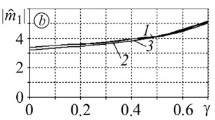By using the numerical solutions of the second-order nonlinear differential equation, we analyze vibrations of a rod under the action of stochastic exciting forces. It is shown that, in the case of initiation of a crack, vibrations acquire the properties of periodic nonstationarity. It is shown that, in the superresonance mode, the characteristics of second-order nonstationarity are more sensitive to the development of the crack than the characteristics of the deterministic component. The application of the diagnostic features constructed on the basis of these characteristics enables us to detect cracks even of small lengths.






Similar content being viewed by others
References
P. C. Paris and G. C. Sih, “Stress analysis of cracks,” in: Fracture Toughness Testing and Its Applications, ASTM STP 381, American Society for Testing and Materials, Philadelphia (1965), pp. 30–85.
V. Z. Parton and E. M. Morozov, Mechanics of Elastoplastic Fracture [in Russian], Nauka, Moscow (1985).
V. I. Beresnevich, Comparative analysis of the mathematical models of fatigue cracks,” Vestn. Nauch.-Tech. Razvit., No. 12 (28), 12–19 (2009).
S. L. Tsyfanskii, M. A. Magone, and V. M. Ozhiganov, “On the use of nonlinear effects for the detection of cracks in rodlike structural elements,” Defektoskopiya, No. 3, 77–82 (1985).
V. V. Matveev, “Efficiency of the method of spectral vibrodiagnostics for the fatigue damage of structural elements. Part 1. Longitudinal vibrations, analytic solutions,” Probl. Prochn., No. 6, 5–20 (1997).
A. B. Roitman, N. B. Aleksandrova, and T. A. Khristenko, “Vibration diagnostics of ‘breathing’ cracks in the products,” Tekh. Diagnost. Nerazrush. Kontr., No. 1, 58–66 (2000).
V. V. Matveev and A. P. Bovsunovskii, “Some aspects of vibration of an elastic body with ‘breathing’ discontinuity of the material,” Probl. Prochn., No. 5, 44–60 (2000).
M. Krawczuk and W. Ostachowicz, “Damage indicators for diagnostics of fatigue cracks in structures by vibration measurements—a survey,” J. Theor. Appl. Mech., 34, No. 2, 307–326 (1996).
A. D. Dimarogonas, “Vibration of cracked structures: a state-of-the-art review,” Eng. Fract. Mech., 55, 831–857 (1996).
O S. Salawu, “Detection of structural damage through changes in frequency: a review,” Eng. Struct., 19, 718–723 (1997).
I. I. Mats’ko, I. M. Yavors’kyi, I. B. Kravets,’ and V. M. Zayats,’ “A model of vibration response of a body with crack,” Vidbir Obrab. Inform., No. 30 (106), 20–30 (2009).
I. I. Mats’ko, I. M. Yavors’kyi, I. B. Kravets,’ and R. M. Yuzefovych, “Influence of the size of a crack on the correlation structure of vibration signals,” Vidbir Obrab. Inform., No. 31(107), 18–26 (2009).
I. I. Mats’ko, I. M. Yavors’kyi, and I. B. Kravets’, “Spectral properties of the vibration signals of a workpiece containing a crack,” Vidbir Obrab. Inform., No. 32 (108), 26–34 (2010).
I. I. Mats’ko, I. B. Kravets’, and I. M. Yavors’kyi, “Analysis of the structure of vibration signals from mechanical systems in the process of growth of a defect,” Fiz.-Khim. Mekh. Mater., 47, No. 1, 29–36 (2011); English translation: Mater. Sci., 47, No. 1, 26–35 (2011).
I. M. Yavors’kyi, and I. B. Kravets,’ I. I. Mats’ko, and R. Yuzefovych, “Probability structure of the vibration signals of a body containing a crack,” Avtomat. Vyrob. Prots. Mashynobud. Pryladobud., No. 45, 452–459 (2011).
A. P. Bovsunovskii, “Comparative analysis of nonlinear resonances in a mechanical system with asymmetric piecewise-linear characteristic of the restoring force,” Probl. Prochn., No. 2, 72–87 (2007).
A. P. Bovsunovskii and О. А. Bovsunovskii, “Application of nonlinear resonances for the diagnostics of closing cracks in rodlike elements,” Probl. Prochn., No. 23, 125–141 (2010).
I. Javorskyj, I. Isayev, J. Majewski, and R. Yuzefovych, “Component covariance analysis for periodically correlated random processes,” Signal Proc., 90, 1083–1102. (2010).
Author information
Authors and Affiliations
Corresponding author
Additional information
Translated from Fizyko-Khimichna Mekhanika Materialiv, Vol. 50, No. 2, pp. 128–136, March–April, 2014.
Rights and permissions
About this article
Cite this article
Mats’ko, І.I., Yavors’kyi, I.M., Yuzefovych, R.M. et al. Analysis of the Vibration State of a Rod Containing a Crack Under the Action of Stochastic Cyclic Loads. Mater Sci 50, 303–313 (2014). https://doi.org/10.1007/s11003-014-9722-7
Received:
Published:
Issue Date:
DOI: https://doi.org/10.1007/s11003-014-9722-7




